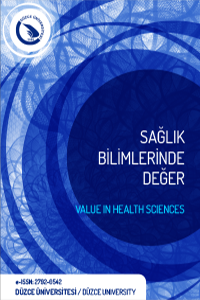Doğum Şeklinin Gençlerin Sağlık Durumu ile İlişkisi
Sezaryen doğum, normal doğum, ebelik, sağlık durumu
The Relation of the Mode of Delivery with the Health Status of Young People
Caesarean delivery, vaginal delivery, midwifery, health status,
___
- 1. who.int [Internet]. Word Health Organization statement on caesarean section rates [Cited: 2018 Agust]. Available from: http://apps.who.int/iris/bitstream/handle/10665/161442/WHO_RHR_15.02_eng.pdf;jsessionid=E1A6A456664168A2A50D69D306255AD8?sequence=1.
- 2. Tuik.gov.tr [Internet]. İstatistiklerle Çocuk [Son güncelleme tarihi: 2016; Erişim tarihi: Ağustos 2018]. Erişim adresi: http://www.tuik.gov.tr/HbPrint.do?id= 24645.
- 3. Fobelets M, Beeckman K, Buyl R, Daly D, Sinclair M, Healy P, et al. Mode of birth and postnatal health‐related quality of life after one previous cesarean in three European countries. Birth. 2018; 45(2): 137-47.
- 4. Kahraman ÖG, Ceylan Ş, Korkmaz E. 0-3 yaş arası çocukların gelişimsel değerlendirmelerinin bazı değişkenler açısından incelenmesi. Mersin Üniversitesi Sağlık Bilimleri Dergisi. 2016; 9(2): 60-9.
- 5. Petrou S, Kim SW, McParland P, Boyle EM. Mode of delivery and long‐term health‐related quality‐of‐life outcomes: A prospective population‐based study. Birth. 2017; 44(2): 110-9.
- 6. Smithers LG, Mol BW, Jamieson L, Lynch JW. Cesarean birth is not associated with early childhood body mass index. Pediatric Obesity. 2017; 12(Supply 1): 120-4.
- 7. Saglik.gov.tr [Internet]. Sağlık istatistikleri yıllığı 2016 [Son güncelleme tarihi: 2017; Erişim tarihi: Haziran 2018]. Erişim adresi: https://dosyasb.saglik.gov.tr/eklenti/13183,sy2016turkcepdf.pdf?0.
- 8. Arslan H, Karahan N, Çam C. The nature of midwifery and its effect on mode of childbirth. Maltepe University Nursing Science and Art Journal. 2008; 1(2): 55-8.
- 9. Internationalmidwives.org [Internet]. Essential competencies for basic midwifery practice [Cited: 2018 Agust]. Available from: http://internationalmidwives.org/assets/uploads/documents/CoreDocuments/ICM%20Essential%20Competencies%20for%20Basic%20Midwifery%20Practice%202010,%20revised%202013.pdf.
- 10. World Health Organization [Internet]. Midwifery [Cited: 2018 Agust]. Available from: http://www.who.int/topics/midwifery/en/.
- 11. Baas CI, Wiegers TA, de Cock TP, Erwich JJH, Spelten ER, De Boer MR, et al. Client‐related factors associated with a “less than Good” experience of midwifery care during childbirth in the Netherlands. Birth. 2017; 44(1): 58-67.
- 12. Carlson NS, Corwin EJ, Lowe NK. Labor intervention and outcomes in women who are nulliparous and obese: comparison of nurse‐midwife to obstetrician intrapartum care. Journal of Midwifery & Women's Health. 2017; 62(1): 29-39.
- 13. Fontein JY. The comparison of birth outcomes and birth experiences of low-risk women in different sized midwifery practices in the Netherlands. Women and Birth. 2010; 23(3): 103-10.
- 14. Akbolat M, Turgut M, Över G. Hemşirelerin yaşam kalitesi algılarının motivasyonlarına etkisi: Bir kamu hastanesi örneği. Manas Sosyal Araştırmalar Dergisi. 2015; 4(2): 65-82.
- 15. Bingöl G, Gebeş R, Yavuz R. Amasya Sağlık Yüksekokulu öğrencilerinin genel sağlık durumlarının bazı değişkenlere göre incelenmesi. Göztepe Tıp Dergisi. 2012; 27(3): 106-11.
- 16. Şentürk M, Etiler N. Kocaeli Üniversitesi’nin üç meslek yüksekokulunda öğrencilerin sağlık düzeylerinin algılanan sağlık ölçeği ve GSA-12 ile değerlendirilmesi, 2007. TAF Preventive Medicine Bulletin. 2009; 8(4): 307-14.
- 17. Uysal N, Yenal K. Hemşirelik öğrencilerinin genel sağlık durumlarının incelenmesi. SDÜ Sağlık Bilimleri Dergisi. 2014; 5(1): 15-20.
- 18. Ware JE. How to score the revised MOS Short-Form Health Scale (SF-36). Boston: MA: The Health Institute; 1988.
- 19. Pınar R. Diabetes Mellitus’lu hastaların yaşam kalitesi ve yaşam kalitesini etkileyen faktörlerin incelenmesi [Doktora tezi]. İstanbul: İstanbul Üniversitesi Sağlık Bilimleri Enstitüsü; 1995.
- 20. Tabachnick BG, Fidell LS. Using multivariate statistics. 6th ed. Boston: Pearson; 2013.
- 21. Yılmaz M, İsaoğlu Ü, Kadanalı S. Kliniğimizde 2002-2007 yılları arasında sezaryen olan hastaların incelenmesi. Marmara Medical Journal. 2009; 22(2): 104-10.
- 22. Coşkun A, Köstü B, Ercan Ö, Kıran H, Güven MA, Kıran G. Kahramanmaraş İl Merkezinde 2004 ve 2006 yıllarındaki doğumların karşılaştırılması. TJOD Dergisi. 2007; 4(3): 168-72.
- 23. Genç A, Şener Ü, Karabacak H, Üçok K. Kadın ve erkek genç erişkinler arasında fiziksel aktivite ve yaşam kalitesi farklılıklarının araştırılması. Kocatepe Tıp Dergisi. 2011; 12(3): 145-50.
- 24. Vural Ö, Eler S, Güzel NA. Masa başı çalışanlarda fiziksel aktivite düzeyi ve yaşam kalitesi ilişkisi. Spormetre Beden Eğitimi ve Spor Bilimleri Dergisi. 2010; 8(2): 69-75.
- 25. Souza JP, Gulmezoglu AM, Lumbiganon P, Laopaiboon M, Carroli G, Fawole B, et al. Caesarean section without medical indications is associated with an increased risk of adverse short-term maternal outcomes: The 2004-2008 WHO global survey on maternal and perinatal health. BMC Medicine. 2010; 8(1): 71.
- 26. Darmasseelane K, Hyde MJ, Santhakumaran S, Gale C, Modi N. Mode of delivery and offspring body mass index, overweight and obesity in adult life: A systematic review and meta-analysis. PloS One. 2014; 9(2): e87896.
- 27. Black M, Bhattacharya S, Philip S, Norman JE, McLernon DJ. Planned cesarean delivery at term and adverse outcomes in childhood health. JAMA. 2015; 314(21): 2271-9.
- 28. Keag OE, Norman JE, Stock SJ. Long-term risks and benefits associated with cesarean delivery for mother, baby, and subsequent pregnancies: Systematic review and meta-analysis. PLoS Medicine. 2018; 15(1): e1002494.
- Yayın Aralığı: Yılda 3 Sayı
- Başlangıç: 2022
- Yayıncı: Düzce Üniversitesi
65 Yaş Üstü Kadınlarda Jinekolojik Sorunlar
Doğum Şeklinin Gençlerin Sağlık Durumu ile İlişkisi
Gizem GÜNEŞ ÖZTÜRK, Zekiye KARAÇAM, Kardelen TAZEGÜL, Leyla Nur KESER
Hipokalsemi Olan Hastalarda Serum Kalsiyum Düzeylerinin İyonize ve Düzeltilmiş Kalsiyum ile İlişkisi
Kalça Kırığı Nedeniyle Cerrahi Tedavi Uygulanan 65 Yaş Üstü Hastaların Bir Yıllık Mortalite Oranları
Multiple Sklerozisde Biyotin Kullanımının Etkileri
Tuğçe TÜCCAR, Tuğba KÜÇÜKKASAP CÖMERT
Geciktirilmiş Umbilikal Kordon Klemplemenin Yenidoğan Sağlığına Etkisi
Gonca KARATAŞ BARAN, Sevil ŞAHİN
Nazogastrik Tüp Uygulama Öğretiminde Yenilikçi Bir Yaklaşım: NAZO-AR
Ebelik Öğrencilerinin Problem Çözme Becerileri ile Öz Etkililik Yeterlik Düzeyleri Arasındaki İlişki
